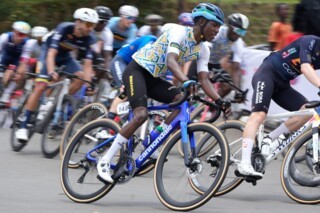At the Roadside in Kigali
Naa Oyo A. Kwate
In the summer of 1892, the city of Peoria, Illinois hosted an under-sixteen track cycling race. Fourteen-year-old Marshall W. Taylor from Indianapolis came third. His participation provoked the ire of his competitors, ‘due wholly to the fact that I was coloured’, as he later wrote in his autobiography. Sometimes he arrived at a track in secret to avoid racial hostility. Eventually, organisers prohibited him from racing in his hometown.
But Taylor persisted, competing elsewhere. At sixteen, he was the only cyclist to cross the finish line in Matthews, Indiana, at the end of a 75-mile road race. He’d given his counterparts a head start of several miles, so they wouldn’t realise he was racing. As he overtook the peloton he was bombarded with a flurry of ‘vile names’, and other racers ‘even threatened … bodily harm’. Taylor, uncowed, was ready to ‘die trying to keep ahead of the bunch of riders’.
He had an uneasy moment passing through the town of Marion, where groups of white riders gathered at the roadside suggested to Taylor a brewing menace. To his surprise, however, they had come to help pace him for the final miles of his winning race. (Years later, on 7 August 1930, Marion was the site of an infamous lynching of two young Black men, Thomas Shipp and Abram Smith.)
Taylor got through Marion unscathed, but during his career he would face insults and physical attacks from both white riders and crowds. Still, ‘Major’ Taylor, as he became known, dominated at the highest level of track cycling domestically and internationally into the early 1900s, and recounted his experiences in a 1928 autobiography.
As Robert Turpin and other historians have shown, Black men and women besides (and before) Taylor were actively engaged in cycling as a professional sport, a leisure activity and a way for making claims on citizenship, as well as simply a means of getting around. Black cyclists fought against racism and against racialised and gendered ideas about their bodies and how they ought to use them in public.
In 2022, in celebration of Black History month, USA Cycling, the official governing body for competitive cycling in the United States, included Taylor as one of ‘fifteen influential Black bike racers to know’, apparently unaware of how sad it was that they had to go back the 1890s to find names for their list. ‘Representation matters,’ they said, and ‘USA Cycling is committed to diversifying American bike racing and we want to see these Black athletes succeed.’ And yet, in September 2025, they sent no Black riders to the Road World Championships in Kigali, Rwanda – the first time the competition, which has been running since 1921, has been held in Africa.
Great Britain didn’t field any Black cyclists either, reflecting a long history of exclusion, as Marlon Moncrieffe has explored. Meanwhile, the few athletes who manage to break through the colour line have been met with racism, whether in smaller European competitions, the Tour de France or races in in the US.
At the World Championships, the thirty or so African teams (plus several from the Caribbean) were structurally disadvantaged in several ways. African cyclists are not recruited as young athletes to ride for World Tour teams, so they have less experience racing at the top levels of the sport. They can’t afford all the equipment and support that their European counterparts have. And merely competing in Europe – the centre of the sport – is often undone by visa denials. Taken together, the likelihood of success for these riders in Kigali was essentially nil.
And yet. At the roadside, we could only delight in seeing racers from a host of African countries; for me, the women especially. I’ve been to the World Championships twice before: in Florence in 2013 and Richmond, Virginia in 2015. At neither could I cheer for young riders like Monica Kiplagat from Kenya or Benin’s Hermionne Ahouissou, tucked in the aerobars during the elite women’s time trial and speeding past an enthusiastic public. I couldn’t call out to my compatriot Victor Akpabli from Ghana as he made his way uphill, and see him smile when he heard his name. There weren’t scores of Black spectators yelling themselves hoarse at the racers, regardless of nation – several of whom looked like the spectators.
It’s always the same when the peloton approaches in a pro race, the signals that tell you the riders are near: police and other motorcycles, race organisation cars, the chopping whirr of the helicopter. I arrived for the men’s elite road race a couple of laps in, and found a spot just after the first right-hand bend on the steep cobbled climb to the Côte de Kimihurura. After several motorbikes rumbled by, another came carrying the time keeper, whose chalkboard announced a 2m50s gap between the peloton and the approaching breakaway.
Here they came, a group of seven riders in various stages of pain, Julien Bernard of France just clinging on at the back. Shortly after they’d passed, the din of two helicopters circling overhead mingled with still more motorbikes. And then a lone rider who had jumped from the front of the peloton. White jersey with yellow, green and light blue markings, blue bike. Eric Manizabayo of Rwanda. The roar was deafening. As he passed, I wondered: is that a smile or a grimace? I think it was both.

Comments
Sign in or register to post a comment